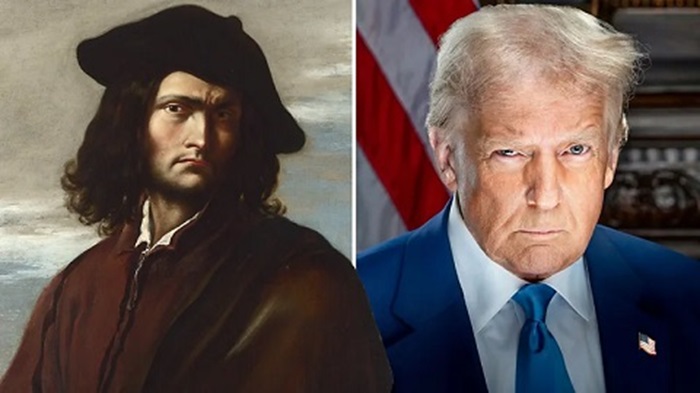FOLLOWING the release of the US president-elect’s official portrait, an expert reveals how scouring the pages of art history can help decode its meaning.
Whether your politics align with those of Donald Trump or not, it is difficult to deny that a string of recent photographs of the former-and-future president of the United States are as visually arresting as any in US political history – instantly etching themselves into cultural consciousness.
The release of Trump’s official presidential portrait last week, ahead of today’s inauguration, completes a triptych of striking images that began with the circulation in late August 2023 of his booking photo, taken after he was indicted in Georgia for conspiring to overturn the results of the 2020 election.
That image, the mugshot heard around the world, was followed, almost a year later, by the astonishing photo of a blood-streaked then-candidate Trump, defiantly pumping his fist in the air after being struck in the right ear by a would-be assassin’s bullet.
Captivating as those first two earlier photos are, the most recent portrait, taken by Trump’s chief photographer, Daniel Torok, and released by his transition team in the lead up to Trump’s retaking of the oath of office, may be the most extraordinary of them all. There is simply no precedent in US presidential portraiture for the piercing intensity of expression and hawkish thrust of stare the image enshrines – an aggressiveness of gaze for which one must scour the pages of art history to find a compelling parallel.
Although Trump may have deliberately sculpted his defiant pose for his mugshot in Atlanta, the staging of neither that photograph nor the dramatic image captured in the chaotic moments after the attempt on his life in Butler, Pennsylvania, in July 2024, were under his control. Torok’s was. Carefully choreographed, every aspect of the official photo is calibrated for maximum impact – from the almost metallic, crepuscular light in which Trump’s face is ignited from below to his severe, asymmetrical squint. The photographer nailed it.
Traditionally, official presidential photographs (even Trump’s own from eight years ago, when he first assumed the high office) are designed to communicate openness and affability. They are serene, smiley, and, almost invariably, forgettable. They seem to say, “better days are on their way”. Not this one. The portentous image is a steely statement of impending purpose. Though journalists have endeavoured to distil the portrait’s essence into everyday language, auditioning words like “scowl” and “stern”, Trump’s expression resists easy captioning. It is, well, strange.
Ever since Aaron Shikler’s famous 1971 painting of a contemplative President John F Kennedy, arm crossing has been the default posture for any reflective executive
To capture the peculiarly penetrating pulse of the president-elect’s mien we really need a new word – one infixed with unflinching triumphant intent. “Trumpant” will do. The closest echo in art history for such a fiercely furrowed, lock-eyed, and, yes, trumpant glare is an out-of-the-way portrait from the paintbrush of the 17th-Century Italian Baroque artist Salvator Rosa, whose intense personification of the scholarly discipline Philosophy (a riveting canvas that resides in London’s National Gallery) is similarly stark. The stares of both images, painting and photo, seem calculated to stave off the slightest whisper of dissent. Rosa’s subject is depicted holding an intimidatory sign that reads “Keep silent, unless your speech is better than silence”.
While ostensibly warmer in its aura, Torok’s photograph of Vice President-elect JD Vance, released together with Trump’s, has an unexpected edginess all its own. It too strikes up an intriguing conversation with images from the history of art. Unlike Trump, Vance is, technically, smiling. But his is more of a guarded, closed-off grin than a wide-open beam. An abiding air of aloof reserve is amplified by Vance’s emphatically folded arms. He is happy enough to see you, but not ready to share.
Too much can be made of Vance’s body language. He is, after all, hardly the first president-or vice-president-elect to cross his arms while posing for an official portrait. Similar stances were adopted by both Joe Biden and Barack Obama for their official portraits. Ever since Aaron Shikler’s famous 1971 painting of a contemplative President John F Kennedy, portrayed with arms folded and deep in
But in Vance’s portrait, it isn’t only his limbs that feel folded. Everything about him appears sealed off and inaccessible. Even his lips seem to be crossing their arms. His focus feels firmly fixed elsewhere, outside the frame, recalling pioneering French artist Paul Cezanne’s inscrutable portrait Man With Crossed Arms, 1899. As with Cezanne’s sitter, Vance’s mind, as much as his body, is wrapped up, tightly bound, and unravelable.
Announcing the release of the official portraits to the media in an email, Trump’s transition team insisted the images “go hard” and punctuated the assertion with a fire emoji. To what extent the photos provide a sneak peek of the impending portrait of America that its new leaders intend to paint remains to be seen.
Source: BBC

